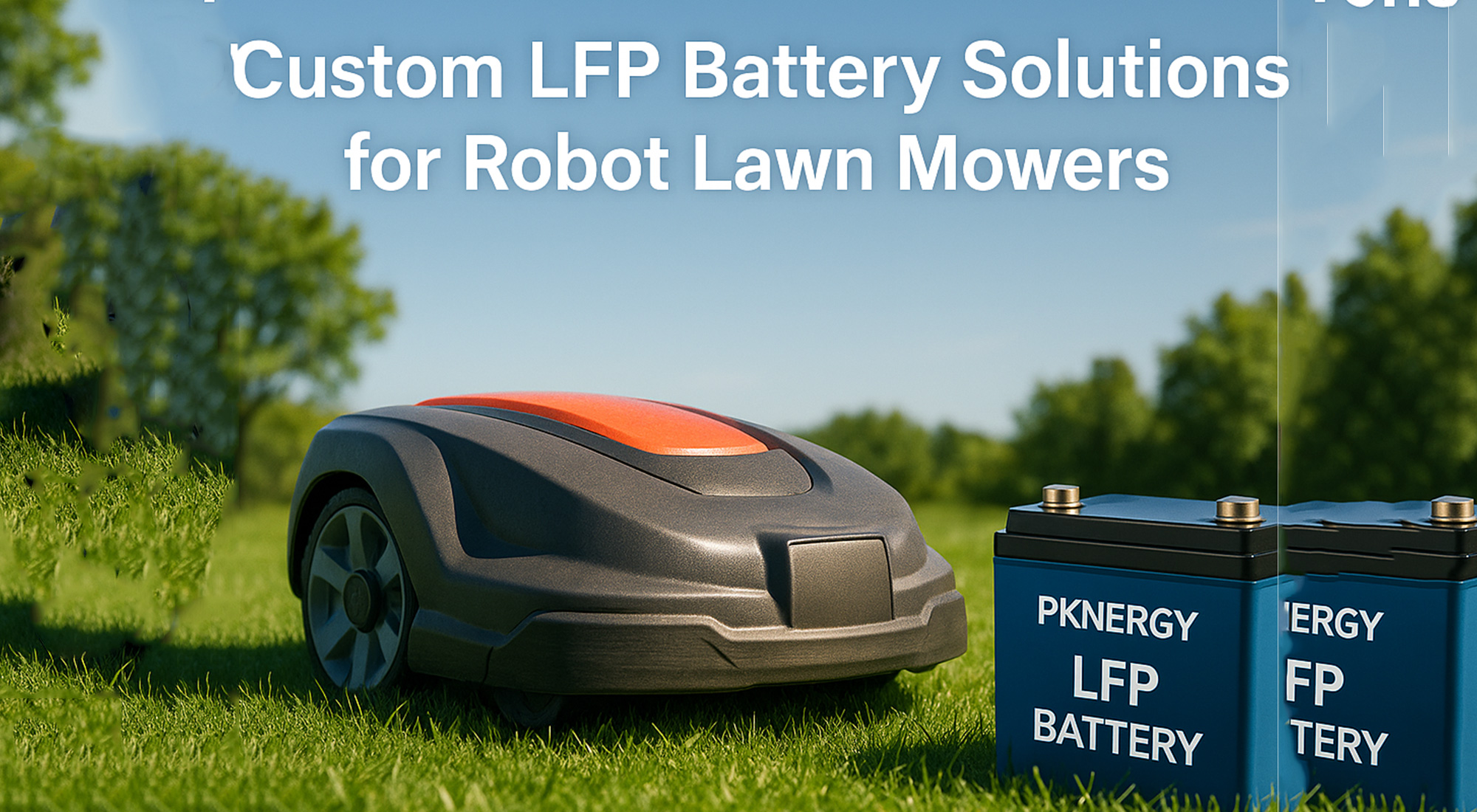
Robot Lawn Mower • Custom LiFePO4 Battery • Outdoor Robotics
Custom LFP Battery Solutions for Robot Lawn Mowers
Robot lawn mowers are evolving fast – but only a rugged, high-power LiFePO₄ battery can keep them cutting
reliably in harsh outdoor conditions. PKNERGY helps brands design custom LFP packs that define torque, runtime
and long-term durability.
navigation, RTK positioning, and obstacle detection become more advanced, the battery system remains the true
core—defining torque, runtime, temperature stability, and overall reliability.Outdoor heat, vibration, humidity, load fluctuation, and frequent charging cycles place extremely high demands on
the battery system. For brands and OEM/ODM developers, the battery is not just a component—it is a strategic
design element that determines product competitiveness. PKNERGY focuses on
custom LiFePO4 battery packs for outdoor robots to help you win this competition.
1. Industry Background — Why the Battery Matters
Robot mowers operate in harsh outdoor conditions:
- Continuous vibration from cutting and drive motors.
- Direct sunlight raising enclosure temperatures above 55–60 °C.
- Sudden load spikes when entering dense or wet grass.
- High-frequency charging during mowing season.
- Humidity, morning dew, and moisture exposure.
These stress factors make the battery a critical determinant of cutting performance, runtime, safety, durability,
and warranty cost. LFP (LiFePO₄) is now the preferred chemistry due to superior safety, long cycle life, and
stable high-current discharge behavior — especially compared with traditional lead-acid or general lithium-ion
solutions used in other
micro-mobility power solutions.
2. Key Technical Requirements for Robot Mower Batteries
The following parameters are essential when designing a competitive robot mower battery system:
| Requirement | Recommended PKNERGY LFP Solution |
|---|---|
| Voltage platform | 10S–15S (32–48 V) for stable torque output of dual-drive and blade motors. |
| Peak discharge | 30–60 A peak to handle dense grass without stalling. |
| Continuous discharge | 10–20 A continuous to support full mowing cycles. |
| High-temperature performance | Stable operation > 55–60 °C in enclosed housings under sun exposure. |
| Vibration resistance | Reinforced holders, welding and nickel layout for long-term stability. |
| Cycle life | 1500–3000 cycles to support multi-season usage and low lifetime cost. |
| Smart BMS | CAN/UART/RS485, accurate SOC and complete protections. |
| Waterproofing | IPX5–IPX7 designs to resist dew, rain and moisture. |
These requirements are similar to those found in other outdoor equipment, such as
solar lighting power solutions, but the higher dynamics and vibration in robot mowers make robust pack
design even more essential.
3. Common Pain Points for Manufacturers
Without a well-engineered battery system, robot mower brands often face:
- Overheating during summer operation.
- Insufficient peak current causing blade stalling in dense grass.
- Rapid capacity decay within one season of heavy use.
- Inaccurate SOC estimation leading to sudden shutdown in the middle of a job.
- Mechanical fitment and cable-routing conflicts inside compact chassis.
- Failure under humidity or moisture due to weak sealing.
- Poor supplier consistency increasing failure rate and warranty cost.
PKNERGY’s custom battery engineering is designed to eliminate these issues from the initial design stage, rather
than trying to fix them in the field.
4. PKNERGY’s Custom LFP Battery Solutions
PKNERGY provides end-to-end custom LFP battery packs tailored to robot mower platforms:
High-power 10S–15S LFP Packs
- Cylindrical 21700/32700 cells for excellent vibration resistance.
- Prismatic LFP cells for compact, high-capacity layouts.
- Stable 30–60 A peak output and 10–20 A continuous discharge.
Outdoor-grade Durability
- Supports up to 60 °C sunlight exposure inside the mower housing.
- Moisture-resistant construction with conformal coatings and sealed casings.
Smart BMS
- CAN/UART/RS485 communication for integration with mower controllers and cloud platforms.
- Accurate SOC and SOH estimation for reliable “remaining runtime” display.
- Full protection: OCP, OVP, OTP, SCP and cell-level balancing.
Rugged Mechanical Structure
- Anti-vibration holders and reinforced welding.
- IPX5–IPX7 waterproof housing and gasket designs.
- Optimized harness layout and connectors to simplify assembly.
Flexible Customization
- Voltage, capacity and discharge rate customized for each mower model.
- XT60 / XT90 / Anderson or fully custom connectors.
- Custom pack shape, housing, and harness routing to fit your chassis.
Full Reliability Testing
- UN38.3 and IEC62133 safety tests.
- High-temperature soak, vibration and drop tests.
- Cycle life verification under real mowing profiles.
For brands planning a full outdoor robotics portfolio, PKNERGY also supports
AGV power solutions and other
lithium battery customization, enabling unified supply across multiple platforms.
5. Application Examples
- 15S high-capacity long-runtime systems for large gardens and professional users.
- 12S cylindrical vibration-resistant packs for rugged residential mowers.
- Moisture-resistant designs for humid regions and coastal climates.
- Fast-charging packs integrated with docking stations for high-utilization fleets.
- High-current solutions for powerful brushless blade motors and multi-zone mowing.
Whatever your robot mower positioning—entry-level consumer, professional landscaping or smart city maintenance—
PKNERGY can match your torque, runtime and cost targets with the right LFP architecture.
FAQ – LFP Batteries for Robot Lawn Mowers
1. Why choose LiFePO₄ instead of NMC or lead-acid for robot mowers?
LiFePO₄ offers very high thermal stability, long cycle life and stable high-current discharge — all critical
for outdoor robots working in high temperatures and vibration. Compared with lead-acid, LFP is lighter and
supports much higher cycle life. Compared with typical NMC, it provides better safety margins for enclosed
plastic housings exposed to sunlight.
2. What information do you need to design a custom battery pack?
We usually need your target voltage (cell count), maximum and continuous current, expected runtime, charging
strategy, available battery space (3D drawing), waterproof rating target, and annual volume. With this
information, we can quickly propose a feasible LFP solution.
3. Can PKNERGY battery packs work with our existing docking station?
In many cases yes. We can adapt the pack voltage, BMS communication and connector layout to match your
current charging dock and control logic, or propose an upgraded system if higher power is required.
4. How do you ensure waterproof and moisture protection?
We combine sealed housings, gasket designs, potting or conformal coating, and carefully routed venting
structures to achieve IPX5–IPX7 levels as required. Validation includes spray, immersion and humidity tests.
5. How can I start cooperation with PKNERGY for robot mower batteries?
Simply share your mower specification and target launch schedule via email or the
Contact Us page. Our
engineering and sales team will provide a quick feasibility check, recommended pack architecture and
quotation.
Contact Miah — PKNERGY
Planning the next generation of robot lawn mowers and need a robust LFP battery partner?
Share your target voltage, current, runtime, housing size and waterproof requirements – Miah will help you build
a safe, durable and competitive battery solution.
Contact Person: Miah Cui
Company: PKNERGY Energy Co., Ltd.
Email: sale@pknergy.com
Phone / WhatsApp: +86 139 0246 3897
Website: https://www.pknergybattery.com
More Info: PKNERGY Battery FAQ
Robot Lawn Mower • Custom LiFePO4 Battery • Outdoor Robotics
Custom LFP Battery Solutions for Robot Lawn Mowers
Robot lawn mowers are evolving fast – but only a rugged, high-power LiFePO₄ battery can keep them cutting
reliably in harsh outdoor conditions. PKNERGY helps brands design custom LFP packs that define torque, runtime
and long-term durability.
navigation, RTK positioning, and obstacle detection become more advanced, the battery system remains the true
core—defining torque, runtime, temperature stability, and overall reliability.Outdoor heat, vibration, humidity, load fluctuation, and frequent charging cycles place extremely high demands on
the battery system. For brands and OEM/ODM developers, the battery is not just a component—it is a strategic
design element that determines product competitiveness. PKNERGY focuses on
custom LiFePO4 battery packs for outdoor robots to help you win this competition.
1. Industry Background — Why the Battery Matters
Robot mowers operate in harsh outdoor conditions:
- Continuous vibration from cutting and drive motors.
- Direct sunlight raising enclosure temperatures above 55–60 °C.
- Sudden load spikes when entering dense or wet grass.
- High-frequency charging during mowing season.
- Humidity, morning dew, and moisture exposure.
These stress factors make the battery a critical determinant of cutting performance, runtime, safety, durability,
and warranty cost. LFP (LiFePO₄) is now the preferred chemistry due to superior safety, long cycle life, and
stable high-current discharge behavior — especially compared with traditional lead-acid or general lithium-ion
solutions used in other
micro-mobility power solutions.
2. Key Technical Requirements for Robot Mower Batteries
The following parameters are essential when designing a competitive robot mower battery system:
| Requirement | Recommended PKNERGY LFP Solution |
|---|---|
| Voltage platform | 10S–15S (32–48 V) for stable torque output of dual-drive and blade motors. |
| Peak discharge | 30–60 A peak to handle dense grass without stalling. |
| Continuous discharge | 10–20 A continuous to support full mowing cycles. |
| High-temperature performance | Stable operation > 55–60 °C in enclosed housings under sun exposure. |
| Vibration resistance | Reinforced holders, welding and nickel layout for long-term stability. |
| Cycle life | 1500–3000 cycles to support multi-season usage and low lifetime cost. |
| Smart BMS | CAN/UART/RS485, accurate SOC and complete protections. |
| Waterproofing | IPX5–IPX7 designs to resist dew, rain and moisture. |
These requirements are similar to those found in other outdoor equipment, such as
solar lighting power solutions, but the higher dynamics and vibration in robot mowers make robust pack
design even more essential.
3. Common Pain Points for Manufacturers
Without a well-engineered battery system, robot mower brands often face:
- Overheating during summer operation.
- Insufficient peak current causing blade stalling in dense grass.
- Rapid capacity decay within one season of heavy use.
- Inaccurate SOC estimation leading to sudden shutdown in the middle of a job.
- Mechanical fitment and cable-routing conflicts inside compact chassis.
- Failure under humidity or moisture due to weak sealing.
- Poor supplier consistency increasing failure rate and warranty cost.
PKNERGY’s custom battery engineering is designed to eliminate these issues from the initial design stage, rather
than trying to fix them in the field.
4. PKNERGY’s Custom LFP Battery Solutions
PKNERGY provides end-to-end custom LFP battery packs tailored to robot mower platforms:
High-power 10S–15S LFP Packs
- Cylindrical 21700/32700 cells for excellent vibration resistance.
- Prismatic LFP cells for compact, high-capacity layouts.
- Stable 30–60 A peak output and 10–20 A continuous discharge.
Outdoor-grade Durability
- Supports up to 60 °C sunlight exposure inside the mower housing.
- Moisture-resistant construction with conformal coatings and sealed casings.
Smart BMS
- CAN/UART/RS485 communication for integration with mower controllers and cloud platforms.
- Accurate SOC and SOH estimation for reliable “remaining runtime” display.
- Full protection: OCP, OVP, OTP, SCP and cell-level balancing.
Rugged Mechanical Structure
- Anti-vibration holders and reinforced welding.
- IPX5–IPX7 waterproof housing and gasket designs.
- Optimized harness layout and connectors to simplify assembly.
Flexible Customization
- Voltage, capacity and discharge rate customized for each mower model.
- XT60 / XT90 / Anderson or fully custom connectors.
- Custom pack shape, housing, and harness routing to fit your chassis.
Full Reliability Testing
- UN38.3 and IEC62133 safety tests.
- High-temperature soak, vibration and drop tests.
- Cycle life verification under real mowing profiles.
For brands planning a full outdoor robotics portfolio, PKNERGY also supports
AGV power solutions and other
lithium battery customization, enabling unified supply across multiple platforms.
5. Application Examples
- 15S high-capacity long-runtime systems for large gardens and professional users.
- 12S cylindrical vibration-resistant packs for rugged residential mowers.
- Moisture-resistant designs for humid regions and coastal climates.
- Fast-charging packs integrated with docking stations for high-utilization fleets.
- High-current solutions for powerful brushless blade motors and multi-zone mowing.
Whatever your robot mower positioning—entry-level consumer, professional landscaping or smart city maintenance—
PKNERGY can match your torque, runtime and cost targets with the right LFP architecture.
FAQ – LFP Batteries for Robot Lawn Mowers
1. Why choose LiFePO₄ instead of NMC or lead-acid for robot mowers?
LiFePO₄ offers very high thermal stability, long cycle life and stable high-current discharge — all critical
for outdoor robots working in high temperatures and vibration. Compared with lead-acid, LFP is lighter and
supports much higher cycle life. Compared with typical NMC, it provides better safety margins for enclosed
plastic housings exposed to sunlight.
2. What information do you need to design a custom battery pack?
We usually need your target voltage (cell count), maximum and continuous current, expected runtime, charging
strategy, available battery space (3D drawing), waterproof rating target, and annual volume. With this
information, we can quickly propose a feasible LFP solution.
3. Can PKNERGY battery packs work with our existing docking station?
In many cases yes. We can adapt the pack voltage, BMS communication and connector layout to match your
current charging dock and control logic, or propose an upgraded system if higher power is required.
4. How do you ensure waterproof and moisture protection?
We combine sealed housings, gasket designs, potting or conformal coating, and carefully routed venting
structures to achieve IPX5–IPX7 levels as required. Validation includes spray, immersion and humidity tests.
5. How can I start cooperation with PKNERGY for robot mower batteries?
Simply share your mower specification and target launch schedule via email or the
Contact Us page. Our
engineering and sales team will provide a quick feasibility check, recommended pack architecture and
quotation.
Contact Miah — PKNERGY
Planning the next generation of robot lawn mowers and need a robust LFP battery partner?
Share your target voltage, current, runtime, housing size and waterproof requirements – Miah will help you build
a safe, durable and competitive battery solution.
Contact Person: Miah Cui
Company: PKNERGY Energy Co., Ltd.
Email: sale@pknergy.com
Phone / WhatsApp: +86 139 0246 3897
Website: https://www.pknergybattery.com
More Info: PKNERGY Battery FAQ

